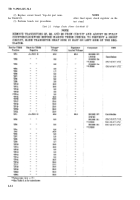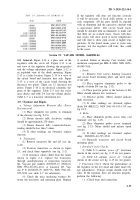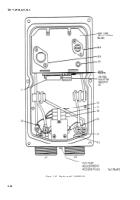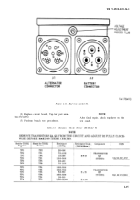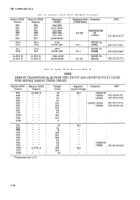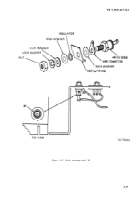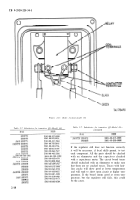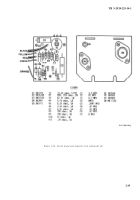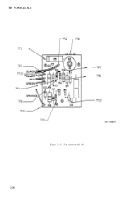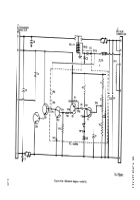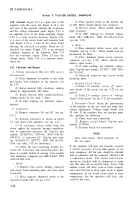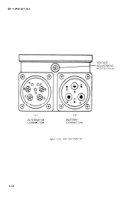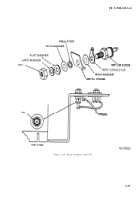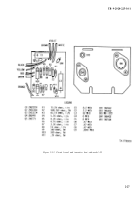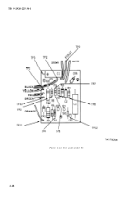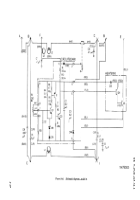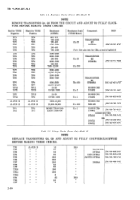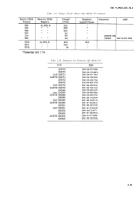TB-9-2920-225-34-1 - Page 28 of 70
TB 9-2920-225-34-1
Section V. VAP-AIR MODEL 26440001-05
2-10. General.
Figure 2–17 is a plan view of the
regulator with the cover off. Figure 2–18 is the
end view of the regulator showing the receptacles
and the voltage adjustment point. Figure 2-19 is
an exploded view of the diode mounting. Figure
2-20 is a relay location drawing. Figure 2-21
is a view of the circuit board and transistor heat
sink. Figure 2–22 is a view of the circuit board
showing the electrical test points. There are 12
electrical test points. Figure 2–23 is an electrical
schematic diagram of the regulator. Table 2–8
lists the resistance checks. Table 2-9 lists the
voltage checks. Table 2-10 is a transistor substi-
tution list.
2-11. Checkout and Repair.
a. Voltage Adjustment Rheostat (R2) (power
disconnected).
(1) Place ohmmeter test probes to the violet
and brown wire terminals of the rheostat (see
fig. 2-17) .
(2) Rotate rheostat fully clockwise, reading
should be approximately 250 ohms.
(3) Rotate rheostat fully counterclockwise,
reading should be less than 5 ohms.
(4) If other readings are obtained, replace
rheostat.
b. Transistors.
(1) Remove transistors Q4 and Q5 (see fig.
2-17).
(2) Position transistors as shown in figure
2-1, and check each separately (see fig. 2–2).
(3) If resistance values differ from the
above, replace the transistors through cannibaliza-
tion or requisition transistor Q4, Vap-Air part
number 26316033-12 (2N3441), NSN 5961-00–
054-4141, or transistor Q5, Vap-Air part num-
ber 26316033–70 (2N3773), NSN 5961-00–929–
5014 (see table 2–10 for substitutes).
(4) Check the mica insulating washers be-
tween the transistors and mounting plate. Re-
place if cracked, broken or missing. Coat washers
with insulation compound per MIL-S-8660, NSN
6850–00–880-7616.
c. Diode.
(1) Remove four screws holding transistor
and circuit board mounting plate, and move plate
to one side.
(2) Place negative ohmmeter probe to the
top side of diode CR3 (see fig. 2-19).
2-22
(3) Place positive probe to the bottom side
of CR3. Meter should indicate low resistance.
(4) Reverse probes. Meter should indicate
high resistance.
(5) If other readings are obtained replace
diode CR3 (MR1122), NSN 5961-00-103-1519
(see fig. 2-19).
d. Relay.
(1)
Place ohmmeter probes across relay coil
terminals (see fig. 2–20 ). Meter should read ap-
proximately 60 ohms.
(2) Place ohmmeter probes across contactor
terminals (see fig. 2–20). Meter should read
infinity (open circuit ).
(3) If other readings are obtained, replace
relay, Vap-Air part number 27124377, NSN 2920-
00–735-9542.
(4) Reinstall transistor and circuit board
mounting plate.
e. Detailed Circuit Checks.
(1)
Table 2-8 contains
“power off”
resist-
ance checks of the circuit (see fig. 2–22 for test
points).
(2) Table 2–9 contains
“power on”
voltage
checks of the circuit (see fig. 2–22 for test points).
f. Functional Checks.
Check the performance
of the regulator on the test stand and make final
voltage adjustments. Voltage output should read
28 volts. If the regulator does not function prop-
erly, perform the following:
(1) Check wires and connections.
(2) Replace circuit board, Vap-Air part
number 27534930.
(3) Perform bench test procedures.
NOTE
After final repair, check regulator on
the test stand.
If the regulator still does not function correctly
it will be necessary, if local skills permit, to test
each component. All the parts should be checked
with an ohmmeter and the capacitors checked with
a capacitance meter.
The circuit board traces
should be checked with an ohmmeter to make
sure that there are no cracked traces. Traces with
hairline cracks will show good at lower tempera-
tures and will tend to show open circuit at higher
temperatures. If the board seems good at room
temperature, but the regulator still fails, this
could be the cause.
Back to Top

